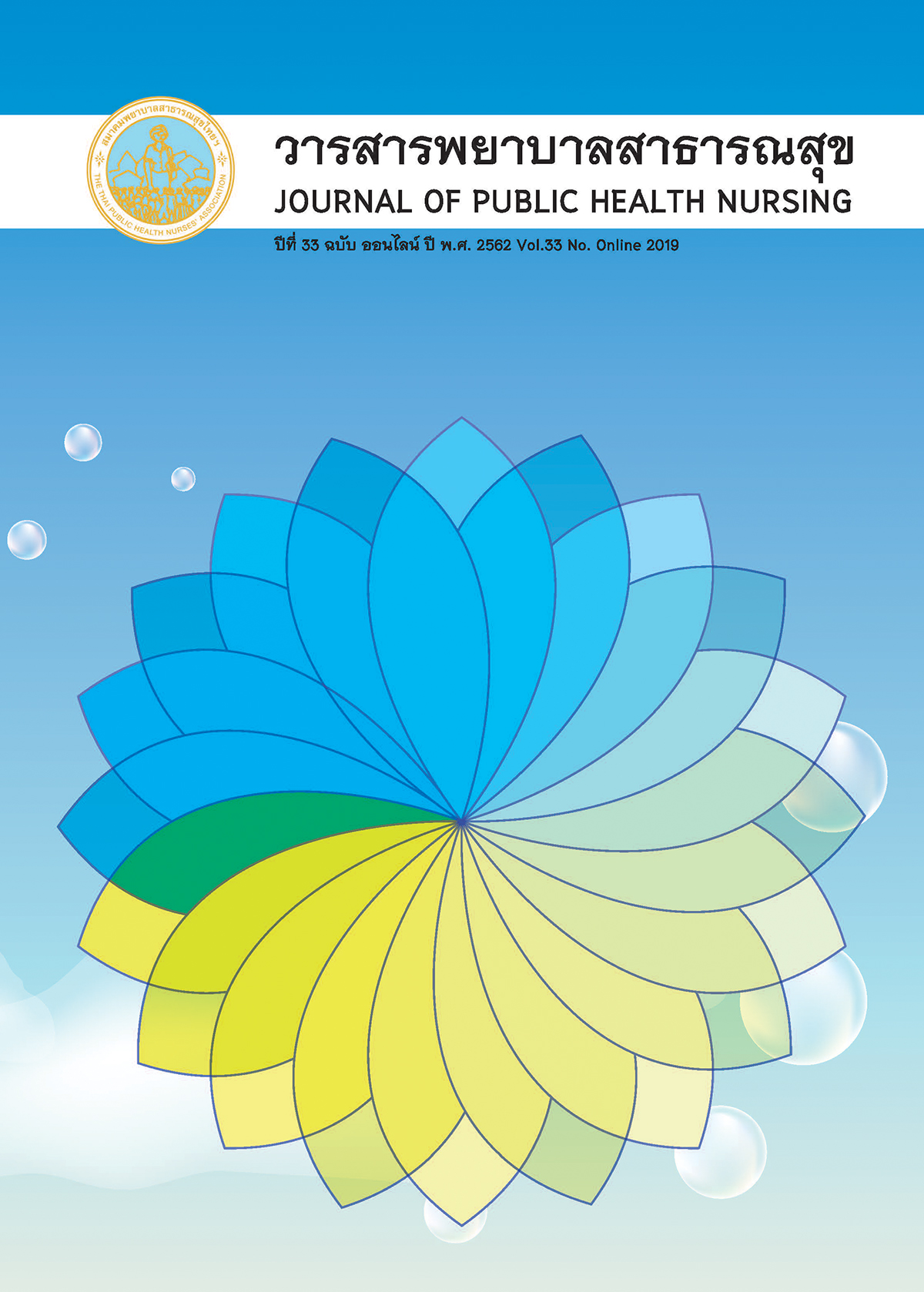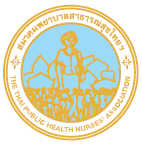Generational Models in Nursing Administration in the Ambulatory Care Nursing Service Division
Keywords:
Generation, Nursing Administration, Shared Governance ModelsAbstract
Generational differences by age often dictates nurse’s needs and affects nursing operations in healthcare organizations. There is a need for nursing administrators to understand and learn the unique characteristics of nurses in each age range. This will ensure adaptive nurse administration in the organization, including appropriate assignment of workload for the different needs of nursing personnel by each age and bring work satisfaction in the organization. This article considers three main factors: 1) Generational age groups: Baby Boomers, Generation X and Generation Y, 2) Nursing Administration, and 3) Shared Governance Models in developing guidelines for nursing administration in the Ambulatory Care Nursing Service Division, Nursing Department, Faculty of Medicine, Ramathibodi Hospital. Age ranges by age division were: Baby Boomers were between 52 and 60 years old, Generation X was between 40-51 years of age and Generation Y, between 20-39 years. Nursing administration concepts for each group were used to developed meaningful leadership and practice for optimal work outcomes. This example illustrates how a guideline for nurse administrators can be applied to manage nurse personnel in an organization based on knowledge, understanding, beliefs, attitudes and behaviors by generational group. This can be an important driving force to enable healthcare organizations to achieve their goals.
References
2. Tassanaananchai P, Prachusilpa G. The management characteristics of generation Y professional nurse, Kuakarun Journal of Nursing. 2014; 21(1): 126-38. (in Thai)
3. Sarnobat S. Generation gap - reasons, effects and solution. [Internet]. 2011 [cited 2019 October 9].Available from: https://www.indiastudychannel.com /resources/136541-Generation-gapreasons- effects-solution.aspx.
4. Sawangdee G. A study of supply of nursing personnel in Thailand. Nonthaburi: Bureau of Nursing, Department of Medical Services, Ministry of Public Health; 2008. (in Thai)
5. Kantha A, Ketchum D, Sawangdee G, Theerawit T. Migration of professional nurses in Thailand, Journal of the Nursing Council. 2013; 28(3): 19-31. (in Thai)
6. Nursing administration. Statistics of nursing personnel Faculty of Medicine, Ramathibodi Hospital. Bangkok: Nursing Administration Ramathibodi Hospital, Faculty of Medicine, Ramathibodi Hospital, Mahidol University; 2016. (in Thai)
7. Sirithorn C, Jiraprawat V. Media exposure and consumer acceptance of Generation X and Generation Y consumers, Journal of Public Relations and Advertising. 2012; 5(2): 111-30. (in Thai)
8. Dorsey JR. Y-Size Your Business: How Gen Y Employees Can Save You Money and Grow Your Business. New Jersey: John Wiley & Sons, Inc.; 2010.
9. Glass A. Understanding generational differences for competitive success, Industrial and Commercial Training. 2007; 39(2): 98-103.
10. Dechawattanapaisan D, Numphaya K, Nuanlak J, Pluemboon C. A Study of Viewpoints and Expectations of Generational Characteristics between Generation X and Generation Y, Journal of Chulalongkorn Business Review. 2014; 36(3): 1-17. (in Thai)
11. Chaloeykitti, P. Baby Boomers and Generation X’s Perception toward Generation Y Behavior in the Workplace: A Study of Architectural Organization. [Master of Business Administration dissertation]. Nakornpathom: Faculty of Graduate Studies Mahidol University, 2013.
12. Kampalikit S. Using ICNP in nursing administration [Internet]. 2014 [cited 2014 August 12]. Available from: www.med.cmu.ac.th%2Fhospital%2F nis%2Ficnp%2FICNP%2557managem ent.ppt&ei=nwCrVdeDItCduQT59YHQ Ag&usg=AFQjCNEm_VwzDXAsJlmCFks2JZq3rJ6VA. (in Thai)
13. Sriyanlak N. Management concepts and theories. In Sriyanlak N (Editor). Nursing Administration. Nonthaburi: Thanaphan Company Limited; 2009; 1- 38. (in Thai)
14. Kutney-Lee A, Germack H, Hatfield L, et al. Nurse engagement in shared governance and patient and nurse outcomes, J Nurs Adm. 2016;46(11): 605–12.
15. Clavelle JT, O'Grady TP, Drenkard K. Structural empowerment and the nursing practice environment in Magnet® organizations, J Nurs Adm. 2013;43(11):566–73.
16. Patricia FJ, Harkness L, Pritchard A, Pullen RL. Seven steps to academic shared governance, Nursing2018: 2018; 48(10):11–14.
17. Suharitdamrong W, Phanichan B, Wayupap A. Supply Chain Science: Supply Chain Science. Bangkok: EI Square Publishing; 2010. (in Thai)
18. Phongsiri N. HR Management Trends 2012 [Internet]. 2012 [cited 2016 April 1]. Available from: http://www. nationejobs.com/content/manage/co ncept/ template.php?conno=1187 (in Thai)
19. Bunthong T. National policy for nursing professional development [Internet]. 2015 [2016 November 16]. Available from: http://www.tnc.or. th/files/2015/11/new_39433/nationa _policy_for_nursing_development _30024.pdf (in Thai)
20. Traithepchanapai L. Processes and performance of service quality development of public health service centers 39 Ratburana, Journal of Public Health Nursing. 2015; 29(3): 103-22. (in Thai)
21. Alsop R. The Throphy Kids Grow Up: Hoe the Millennial generation is shaking up the workplace. New Jersey: Jossey-bass; 2008.
22. Parry E, Urwin P. Tapping into talent: the Age factor and Generation Issues. London: The Chartered Institute of Personnel and Devilopment; 2009.
23. Stanley D. Congruent Leadership: Values in Action, Journal of Nursing Management. 2008; 16(5): 519-24.
24. Steele BJ, Acuff JM. Theory and Application of the “Generation” in International Relations and Politics. New York: Palgrave Macmillian; 2012.
25. Tulgan B. Not Everyone Gets A Trophy: How to Manage Generation Y. San Francisco: Jossey – Bass; 2009.
26. Wong M, & et al. Generation Differences in Personality and Motivation: Do They Exist and What Are The Implications For The Workplace?, Journal of Managerial Psychology. 2008;. 23(8): 878
Downloads
Published
How to Cite
Issue
Section
License
บทความที่ตีพิมพ์และแผนภูมิรูปภาพถือเป็นลิขสิทธิ์ของวารสารพยาบาลสาธารณสุข (Thai Public Health Nurses Association)







